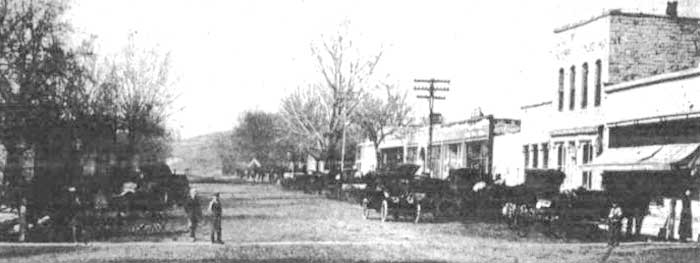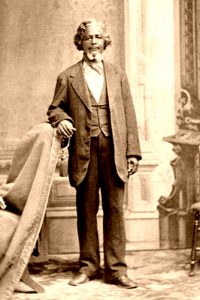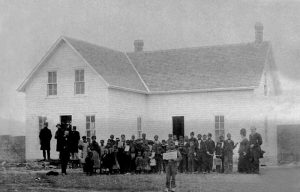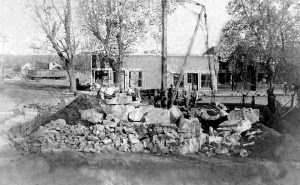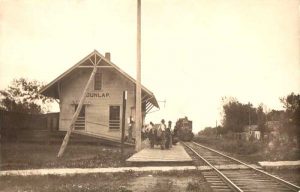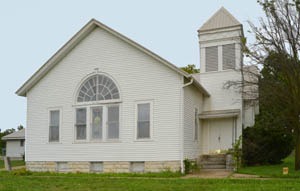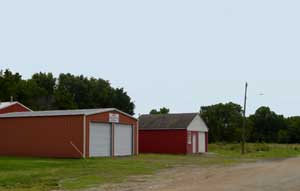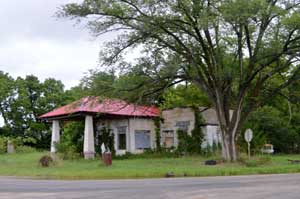Dunlap, Kansas, was founded in 1869 by Joseph Dunlap, an Indian agent for the Kanza tribe. The town was situated on the Missouri, Kansas & Texas Railway; however, it grew very little over the first five years. In March 1874, a post office was opened and first called Hillsborough; however, the very next month, the name was changed to Dunlap. A man named Leonard Still established the first store in August. It was just the third building erected in the town. The settlement then began to grow, and in 1875, it was incorporated.
In the spring of 1878, Benjamin “Pap” Singleton, a former slave who escaped to freedom in 1846, chose Dunlap as a place to relocate numerous freedmen known as “Exodusters.” In May, the freedmen came by the hundreds from the post-Reconstruction South to seek homesteads in what was called the Singleton Dunlap Farm Colony.
When the Exodusters first came to the community, many white settlers resented them, sure that they were a threat to the community’s economy. In the beginning, the African-Americans were forced to attend different schools have their own churches and cemetery, and some businesses wouldn’t even let them come through the doors.
In 1880, the Presbyterian Church founded the Freedmen’s Academy of Kansas in Dunlap to provide an education to African-American settlers. In 1882 the Academy served 90 male and 85 female students, of whom 45 were listed as ex-slaves.
“There are gathered at Dunlap and vicinity at the present time between 275 and 300 families of colored people, all of whom are succeeding quite well and many of whom are on the road to prosperity. The plan of Dunlap Colony is very simple, the chief reason, probably, of the success met with, being the fact that every settler is compelled to own his property, no renting being permitted … as Mr. Atchison expressed it, “everyone is fat and happy…”
— Topeka Daily Capital, October 1882

John Summer and his family standing in front of their home located two miles northeast of Dunlap, Kansas.
By 1889 the Academy had sold most of its real estate holdings, but Dunlap’s population peaked in 1890 with 408 residents. The black population declined by over 50% in the next decade, and the academy closed its doors in the early 1890s. The Academy building then sat vacant until 1895, when Dunlap businessman Alfred Parrish purchased the neat two-story frame structure and moved it several blocks to Commercial Street. It served as his family’s residence for several decades. However, after Parrish’s death, it was left vacant, and eventually, it burned to the ground.
Like other rural areas in Kansas, citizens, both black and white, gradually left the farms and moved to cities. However, the small town continued to maintain its population, and by 1900 was still called home to about 400 people.
In the early years of the 20th century, Dunlap experienced a building boom. A large attractive stone city hall was built on Main Street, and two new brick schools — a grade school and a four-year high school replaced a burned-out old stone school. A department store, grocery store, a Farmers Union Co-op, drug store, an opera house, a funeral parlor, restaurants, a blacksmith shop, a car dealership, two filling stations, two banks, a livery barn, a mercantile company, and a hotel for visitors arriving at the Missouri–Kansas–Texas Railway (KATY) Depot all provided the usual services of a small town.

Though Dunlap’s old 1918 high school gymnasium continues to stand, the school that stood next to it has long since been torn down. By Kathy Alexander.
By 1910, the population of the small town was about 333 and its location on the Neosho River, in the midst of rich agricultural land, had made the community an important shipping point for portions of Morris, Chase, and Lyon Counties. By this time, the town boasted a blacksmith shop, hardware store, grocery store, ice cream parlor, flour mill, a butter and cheese factory, restaurant, the Guarantee State Bank, a hotel, and Baptist, Congregational, and Methodist churches.
In 1913 the United Methodist Church was built, and the high school gymnasium was erected in 1918. Both buildings continue to stand today.
After World War I, black children began attending integrated schools in Dunlap, and segregation subsided long before it did in the rest of the country. In 1920 there were two black churches and several white churches. A stone quarry was nearby, and regular passenger and freight traveled along the railroad, providing a demand for labor and shipping.
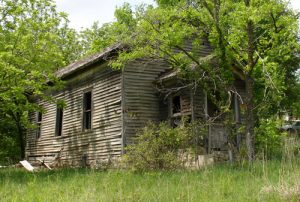
The all-black Baptist Church in Dunlap about to collapse, photo by Galen R Frysinger. The building totally collapsed since this photo was taken and is gone today.
By the 1930s, whites and blacks attended the same schools and churches, ate at the same tables, and drank from the same fountains. However, this was the same time that the Dust Bowl also occurred, resulting in difficulties in growing crops.
During the Great Depression, the town began to decline, and its bank failed. Afterward, numerous people began to leave the community searching for jobs in larger cities. The African-Americans who had long celebrated Emancipation Day did so for the last time in 1931. By this time, the community was called home to less than 100 African-Americans, and that number continued to decline over the next several decades. Encumbered by numerous floods in the area, the population dropped to 219 by 1940.
Two black churches remained open until the early 1950s, but in the end, each was supported by only a handful of families. Neither survives today.
The Katy Railroad ended its passenger traffic through Dunlap in 1952, eventually tearing up their tracks in 1957. By 1960, the population had dropped to 134.
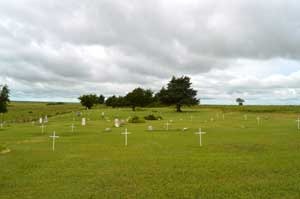
The African American Cemetery in Dunlap, Kansas is listed on the National Register of Historic Places by Kathy Alexander.
The high school closed in 1962, and the grade school, damaged by a storm that ripped off its roof, closed in 1978. In the meantime, the buildings along Main Street were torn down, and nothing remains of those buildings. The high school was torn down somewhere along the line, but the 1918 gymnasium remains, which is maintained by the Volunteer Fire Department. The Dunlap post office closed in 1988.
The last black resident in Dunlap, London A. Harness, died on April 27, 1993, and was the last person to be buried in Dunlap African American cemetery. Until recent years, Dunlap’s black history existed in an old wooden Baptist Church. Unfortunately, the building collapsed in 2014, and the debris was removed the following year. Today, Dunlap’s black history visually remains only in the cemetery.
The Dunlap Colored Cemetery, listed on the National Register of Historic Places today, is approximately one-half mile north and east of the town of Dunlap and nine miles southeast of Council Grove. The earliest burials in the cemetery date to 1880; the last interment was in 1993.
The rest of Dunlap has not fared much better. Called home to about 30 area residents, the community is a virtual ghost town with numerous abandoned buildings, paint-peeling houses, concrete foundations, and sidewalks that lead to nowhere that testify to more prosperous times.
The Methodist Church in Dunlap disbanded in 2014, and the building was donated to the Morris County Historical Society. It is the best-maintained building in Dunlap today.
Besides farming, the town has only a few scattered residences, a co-op, and a volunteer fire department. An old and dilapidated gas station sits at the entrance to the town, and the streets are dirt and gravel.
Dunlap is located about nine miles southeast of Council Grove.
©Kathy Alexander/Legends of Kansas, updated February 2022.
Also See:
African-Americans History in the United States
Nicodemus – A Black Pioneer Town
Sources:
Cemetery Nomination Register of Historic Places
Hickey, Joseph V., “Pap” Singleton’s Dunlap Colony
New Prairie Press
Wikipedia

